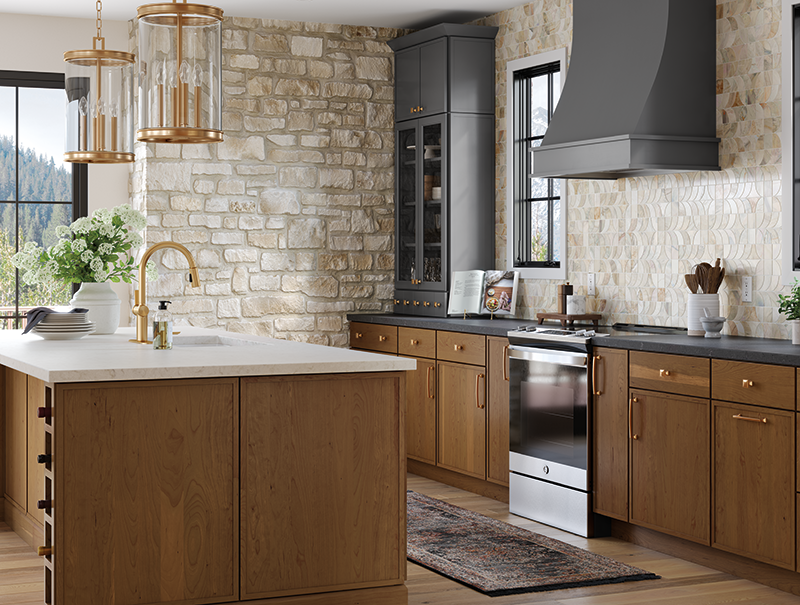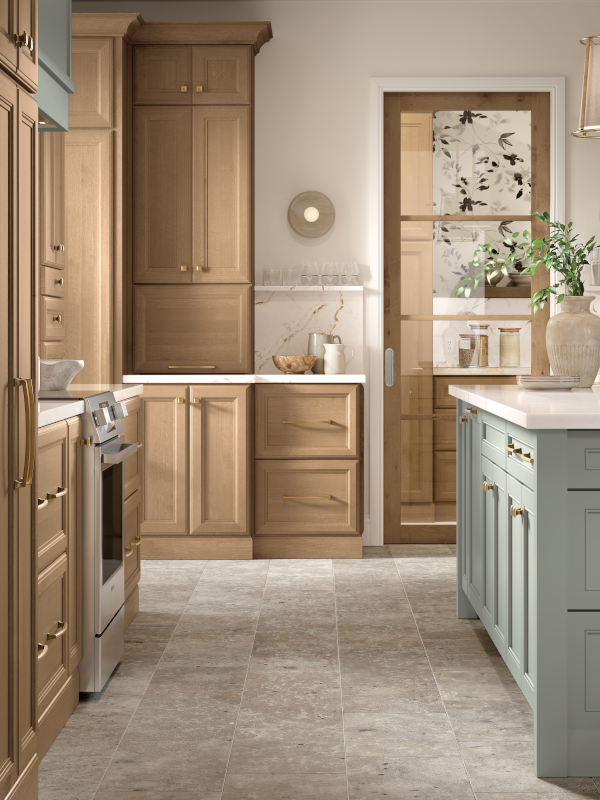Top choices for stunning wood kitchen cabinets

Choosing a wood species for your wood kitchen cabinets is an important step in the design process that can impact many elements of your kitchen, from finish to style to lighting. However, we know there are many different types of wood to choose from, and we’re here to help you decide which will work best for you.
While paints are very popular in the kitchen right now (see our post about on-trend greens), they are mainly used on Maple or medium-density fiberboard (MDF) cabinets because their smooth surfaces let the paint color truly shine. Meanwhile, people usually select stains when they want to see the dimension or characteristics of the natural wood cabinets through the finish. As stains are making a comeback, it’s important to understand that deciding on the right wood species is just as critical as choosing a finish.
If you elect to go with a wood stain, you should also take into consideration the varied characteristics of each style of wood, as these attributes can sometimes influence style choices. To be confident in your species and stain combination, always remember to order a large door sample of the wood of your choice with your favorite stain applied, and ensure you are reviewing the sample in your home. Your home’s natural light, interior light, and other interior surroundings can adjust the look of the cabinetry throughout the day.

Maple wood kitchen cabinets with a mix of painted and stained finishes. Photo from MasterBrand Cabinets.
If you’d like to see how different wood species, paints, and stains would look in your space, the Rebode Kitchen Jumpstarter tool allows you to quickly explore your options online. Once you’ve narrowed down your top choices, Jumpstarter can match you with a local kitchen designer who can show you different wood species and finishes in person, help you pick the right one for your space, and work with you to get started on building your dream kitchen.
Characteristics of wood
Below, we’ve provided you with descriptions of the most popular wood species for modern wood kitchen cabinets so you can better understand what type and finish will work best for your space.
Cherry
Cherry wood is characterized by its red undertones, but it may vary in color from white to a deep, rich brown. In fact, this color variation can occur in a single-door panel. Cherry is a close-grained wood with a fairly uniform texture, revealing pin knots and curly graining. While all wood will age with time and the finish will darken, this is especially true for Cherry. This is a sought-after quality in Cherry cabinetry, and those who select it expect this evolution.

Stained Cherry wood kitchen cabinets. Photo from MasterBrand Cabinets.
Maple
Maple is a close-grained hardwood that is predominately white to creamy-white in color, with occasional reddish-brown tones. While Maple typically features uniform graining as compared to other wood species, its characteristic markings may include fine brown lines, wavy or curly graining, bird’s eye dots, and mineral streaks. These traits are natural and enhance Maple’s innate beauty.
Oak
Oak is a strong, open-grained hardwood that ranges in color from white to pink and reddish tones. Streaks of green, yellow, and even black may also appear due to mineral deposits. Oak may contain wormholes and wild, varying grain patterns. This distinct graining is considered a desirable quality and has made Oak one of the most popular woods used for modern kitchen cabinets.
Quartersawn Oak

Stained Quartersawn Oak kitchen cabinets with a painted Maple island. Photo from MasterBrand Cabinets.
Quartersawn Oak, meanwhile, features a tight grain or “comb grain.” This grain will manifest in a fairly straight pattern that can range from very close together to quite far apart. It also can have a slight curve in the grain that verges on creating a cathedral pattern—similar to that of flat-cut Oak. Moreover, medullary rays, sometimes called “tiger striping” or “flecking,” are a common characteristic of Oak—not a defect—and show up as shiny patches or scars that cut across the grain of the wood. These rays reflect light differently than the general grain, especially when finished, and they are not usually seen in standard Oak.
Rustic Alder
Rustic Alder wood is characterized by its light brown and reddish undertones and may contain a variety of pinholes, open and closed knots of various sizes and colors, small cracks, bird pecks, mineral streaks, and grain variation. Some knots may have small holes through the panel. In addition, the wood will typically contain color differences caused by variations in minerals found in the soil, which create visible mineral tracks.

Rustic Alder cabinets. Photo from MasterBrand Cabinets.
Alder
Alder has a straight fine textured grain similar to Cherry and Maple. Although classified as a hardwood, it is moderately light in weight and considerably softer than other species. Therefore, care must be taken as Alder will dent and mar easily. This wood species may exhibit grain and color variations, and sapwood can be distinguishable from heartwood. Tight pin knots are sometimes present.
Walnut
Finally, Walnut features a smooth grain, with a color variation that can range from deep chocolate to lighter tones of red/gray/brown. Sapwood areas will be present within Walnut and are lighter in hue, ranging from yellow to light brown. Walnut ages contrary to typical expectations, becoming lighter and more mellow in color over time and with exposure to light.
Getting started
Now that you know more about the different wood species you can use for your wood kitchen cabinets, we want to help you get started on your modern kitchen design. Check out the Rebode Kitchen Jumpstarter tool to decide which wood species and stains suit your space, and get matched with a local designer who can help you start bringing your vision to life.